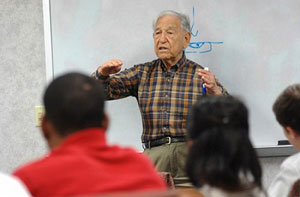By Will Peters
September 4, 2009

Participants in this summer's "Expedition through the Animal Kingdom" pose in their lab coats at VUMC. The program for rural high school students was funded by an NIH stimulus grant. (photo by Anne Rayner)
This summer, Billy Hudson, Ph.D., took 12 high school students from rural Arkansas on an "Expedition through the Animal Kingdom" at Vanderbilt University Medical Center.
The eight-week-long summer research program was an extension of the Aspirnaut Initiative, a program that Hudson and his wife, Julie Hudson, M.D., created in 2007 to stimulate students' interest in science.
The program was supported by $103,000 in federal funding, part of a $320,000 stimulus grant that Hudson received this year from the National Institute of Diabetes and Digestive and Kidney Diseases.
The grant not only supported Hudson's research, but it provided stipends to 10 "Aspirnauts," four students from Berea College in Kentucky, eight Vanderbilt undergraduate students, and two other "Aspirnauts" who spent their summer at the Mount Desert Island Biological Laboratory in Maine.
Hudson, director of the Vanderbilt Center for Matrix Biology, had an ulterior motive. He and his colleagues had just discovered a chemical bond that stabilizes collagen molecules and had never before been found in biological tissues.
To learn more about how and why it evolved, Hudson recruited his young charges to look for it in tissues from different species throughout the animal kingdom.

Nobel Laureate Stanley Cohen, Ph.D., was on hand this summer to speak to members of the Aspirnaut Initiative. (photo by Anne Rayner)
"I hope it's going to be like going from Earth to Mars," he told the students in June, before setting them off on their individual expeditions. "Every rock you turn over will be a discovery."
Hudson knew his students well.
A half century ago, he was one of them — a young person from a poor family in central Arkansas who was going to quit school to work on a cotton farm. His plans were interrupted by a high school teacher who got him into college, where he discovered his love for science.
Davin Hayes was one of the students who entered a research lab for the first time this summer.
In early June, the 16-year-old was burning brush for a farmer near his home in Omaha, Ark., when the farmer, a friend of Hudson, found out he was interested in science. The news got to Hudson on "a Wednesday, and that Friday morning I was on a bus on the way here," Hayes marveled.
"Before I came … I would just think of (science) as a cool hobby," he said. "I didn't know that there was such thing as a career in science."
Each student pursued an independent research project in addition to the group's collective exploration. Hudson placed students in labs that reflected their outside interests, coupling their passions with their work.
"We can use what we already know, and apply that to what we are doing here," said Andrew Miller, 16, a student in the program who is also from Omaha.
By the end of the eight weeks, the students had found the bond in species that had never been studied before.
Hudson said he hopes to publish that data in a future paper with the students as co-coauthors.
But the greater success, he said, is that his program has helped inspire young people like Andrew Miller, who had thought he could never be a scientist.
"Now that I got to do it, I see that it wasn't just some crazy dream," Miller said. "Suddenly it seems a lot more reachable."
This article originally appeared on the Vanderbilt University Medical Center website. Reposted with permission.